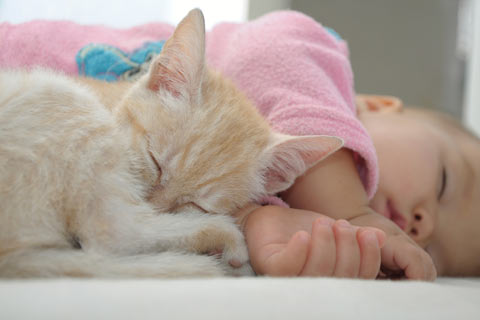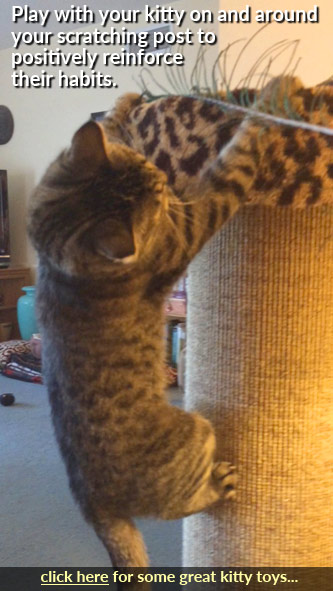- Home
- Cats and Babies: Setting up for Success
Cats and Babies: Setting up for Success

It can be an exciting time: you're expecting a baby! But worrying about whether your first baby, the kitty you've spoiled and doted on, will accept your new human child can introduce stress to the situation. Some people may have even advised you to get rid of your cat to avoid any problems with the baby.
Here's what you need to know about cats and babies including why some people may advocate that you get rid of your cat when you're pregnant, what you can do instead, and how you can prepare for a great cat-kid relationship.
You Don't Have to Get Rid of Your Cat When You're Expecting a Child
Many people who find out they're having a baby seek new homes for their cats or, even worse, send them outside or surrender them to a shelter. This isn't necessary in the huge majority of cases. Below are some of the reasons people consider getting rid of their cats when they are expecting a child and what you can do instead.
-
The risk of toxoplasmosis, a parasite that is transferred from infected cats to people through fecal-oral transmission. A cat that is carrying toxoplasmosis can pass eggs in her stool, and if a pregnant woman ingests them, she can become infected. While the illness is usually not a concern for healthy people or cats, it is known to result in birth defects, miscarriage, and stillbirth of babies. However, there are ways for an expectant mom to protect herself and her child from becoming infected.

- Abstain from cleaning the litter box while pregnant if possible.
- Always wash your hands before eating.
- If you must clean the litter box while you are pregnant, do so at least daily while using gloves. It takes one to three days for toxoplasma eggs to become infective once they are out of the cat's body, so getting rid of the stool often greatly decreases a woman's risk of being infected.
- Take care to use gloves when gardening because outdoor cats may use garden dirt as a litter box.
- Undercooked meat can transmit toxoplasmosis. Eating meat only when it has been well-cooked and wearing gloves while preparing raw meat are important ways for pregnant women to avoid the infection.
- Thoroughly wash and/or peel fruits and vegetables before ingestion because the skins may have toxoplasma eggs on them from contact with infected soil.
- Keep your cat inside to lower her exposure to toxoplasmosis while you are pregnant. Don't get a new cat while you are expecting, and limit your contact with strays and outdoor cats that might be more likely to have a new toxoplasmosis infection than your indoor cat.
- Stay away from children's sandboxes, which are often used as litter boxes by outdoor cats.
- Don't feed your cat a raw food diet while you are pregnant. This is a way in which your cat may contract toxoplasmosis and then shed eggs which may be infective to you.
You can learn more about toxoplasmosis and how to avoid contracting it during pregnancy here: http://www.cdc.gov/parasites/toxoplasmosis/gen_info/pregnant.html.
- The old wives' tale about cats stealing babies' breath or suffocating them. There is a prevailing myth among people that cats will try to suck out an infant's breath, possibly because the smell of milk attracts them. This story probably developed from times in the past: if a cat was found nearby when a deceased infant was discovered, it was assumed that the cat had something to do with the infant's death. This would have been prior to medical science being aware of SIDS. Although they don't purposely suck an infant's breath, a cat could suffocate a newborn baby by lying too close, so cats shouldn't be allowed to interact with or sleep near infants unsupervised.
- Concerns about allergies. Parents sometimes decide to rehome their cat due to concerns about their child developing allergies. Some research has shown that having animals in the home during the first year of life greatly decreases a person's likelihood of developing pet allergies in the future (Ownby DR, 2002). Therefore, keeping your cat and revisiting the issue if your child actually develops symptoms and is diagnosed with pet allergies is a reasonable approach.
- Fears about the cat hurting the child. This is probably the most common reason that people give up their cat when they have a child. No parent wants to risk their child being scratched or bitten by their cat. Luckily, there are some great techniques that you can use to not only decrease the risks of your child or your cat being hurt by one another but also to set your child up for a lifetime of loving animals.
Be Proactive
The best way to ensure that your child's relationship with your cat is safe and mutually beneficial is to be proactive about it. Don't wait until there is a negative incident between them to intervene: set them up for successful interactions from the beginning. Here are some things to do before your baby is born:
- Set up a safe space for the baby to be when you are not with him or her. The first rule of cat-kid interaction is adult supervision. You will need to be sure your baby has a safe place to sleep and hang out when you aren't there. This may be a nursery with a door that closes so the baby can sleep without a curious kitty jumping up to investigate the situation.

Get your cat some scratching posts. Scratching is one way that cats release stress. This is partly because of the physical energy that can be released through a good scratching session and partly because scratching is a way for cats to mark their territory. Marking territory gives a cat peace of mind and helps her feel better about changes in her environment.
- Don't wait until after the baby arrives to get a cat scratching post. It's important to have the post or multiple posts available early so your cat is already familiar with and reliably using them before the baby comes. That way, she will know that she can go directly to the posts and let off some steam if she needs to.
- Make sure that you choose a cat-approved post and help your cat discover its awesomeness.
- Having cat trees and other high spots that are available for your cat to use when the baby comes can go a long way toward helping her feel better about the situation so she'll be less likely to react negatively. Cats like to get high up and survey situations at their own pace, so take advantage of that feline personality quirk.
-
Do what you can to prepare your cat for the new baby. Use your pregnancy as a time to slowly get your cat ready for the arrival of your baby.
- You can play recordings of babies crying and making other noises to get a jumpy cat acclimated to those sounds.
- If you're planning on using a certain type of baby lotion, you can put some on your hands routinely, so your cat gets used to that smell.
- Set up any new furniture that you're planning to have for your baby as far in advance of your due date as possible, to give your cat time to check it out and get used to it. Then, a few weeks before the arrival, place cat deterrents on the furniture that you want her to avoid once the baby comes (changing table, crib, etc.). Double-sided tape and aluminum foil usually work well to teach cats not to jump on certain things.
- Switch cat care roles early. If the pregnant mother is currently the primary cat caretaker and that is likely to change significantly after the baby is born, make the switch as early as possible in the pregnancy rather than waiting until after the baby arrives. For example, if dad or someone else will be feeding, brushing, and playing with the cat more instead of mom, have that person begin to assume those tasks a few months before the due date. This lessens the shock for the cat and allows her time to adjust without associating sudden changes with the baby.
Once the Baby Comes, Continue Your Cat-Satisfying Strategies
When the baby is born, concentrate on keeping things as normal as possible for your cat. This is why you did all the prep work that you did ahead of time: so you could relax and focus on caring for your baby while ensuring that your cat gets what she needs as well. Here are some things to remember:
- When you first arrive home, greet your cat without the baby first. If at all possible, give your cat a few moments of quiet time alone before you bring the baby in for the first time. This will reinforce for your cat that your relationship with her is still important to you.
- Place a used blanket or item of clothing from the baby in a quiet spot so your cat can sniff it at her leisure. You can even have a partner or friend do this before you bring the baby home if possible. This is a nice, low-pressure way for your cat to get used to the idea of the new little person before actually having to deal with the sounds, smells, and hub-bub.
- Keep your baby safe when you aren't with him or her. Cats like to curl up with warm things, especially humans. However, newborns can't move themselves and could be injured or even suffocated by a well-meaning cat. Your cat should not have access to your baby unless you are present. Close your cat out of the room in which your baby is sleeping or use a crib tent if necessary.
- Keep your cat out of your baby's crib at all times. Your cat definitely shouldn't be in the crib while your baby is in it, but she should stay out when it's empty, too. This will keep cat litter and other offensive substances out of your child's sleeping area, decreasing the chances of disease transmission.
- Give your cat some time alone. When you can, be sure to spend quality time with your cat. Though things are sure to be hectic with a new baby in the house, try to spare five minutes as often as you can to pet, groom, and play with your feline friend. It's especially helpful to be sure that she gets time to get her energy out: playing with cat toys that mimic prey behavior can help her release any pent-up stress she might be having about the household's changes.
Spending a little time considering the new baby from your cat's point of view, preparing some ways to help her through the transition, and planning for your baby's safety can help you return to the excitement of expecting a new little one while fostering your relationship with your cat.
Check out our article, "Cats and Kids: Nurturing a Safe Relationship" for tips on how to keep your child and your cat safe as your baby grows out of the newborn stage.
Works Cited
- Ownby DR, J. C. (2002, Aug. 28). Exposure to dogs and cats in the first year of life and risk of allergic sensitization at 6 to 7 years of age. Retrieved from pubmed.gov: http://www.ncbi.nlm.nih.gov/pubmed/12190366
 Loading... Please wait...
Loading... Please wait...



